8 Snakes that Fit in a 20 Gallon Tank
#mobileSnakeQuizControls { overflow: hidden; text-overflow: ellipsis; white-space: nowrap; }
@media (min-width: 481px) {
.mobile-top-content {
display: none;
}
}
#mobileTopContentCTACarouselControls { overflow: hidden; text-overflow: ellipsis; white-space: nowrap; }
.mobile-top-content .more { color: #fff; }
.mobile-top-content a { color: #fff; text-decoration: underline; }
.mobile-top-content a:hover { color: #fff; text-decoration: underline; }
@media (max-width: 480px) {
.mobile-top-content {
background-color: #06a10b;
color: #fff;
text-align: center;
/*height: 60px;
padding-top:5px;*/
font-size:80%;
/* display: block; */
margin: 0px -30px;
}
}
Considering how long snakes can be, finding the appropriate snake for a 20-gallon tank needs to be a calculated decision to ensure you’re able to provide top-notch care to your pet. All 8 snakes on our list are nonvenomous.
A snake is almost always kept in a 20-gallon long tank to accommodate a longer snake. Almost all snakes have a sizeable lifespan, so any snake is a long-term commitment. Only snakes up to four feet long should be kept in a 20-gallon tank.
Most snakes will use a substrate made from shavings, and you must never use aromatic shavings as these will cause respiratory problems. All snakes will also need a hot side and a cool side for their tank, which can vary a few degrees based on species and the individual in question.
button.pulse {
transform: scale(1); animation: pulse 2s infinite;
box-shadow: 0 0 0 0 rgba(11, 247, 25, 1);
}
@keyframes pulse {
0% { transform: scale(0.90); box-shadow: 0 0 0 0 rgba(11, 247, 25, 0.5); }
60% { transform: scale(1); box-shadow: 0 0 0 15px rgba(11, 247, 25, 0); }
100% { transform: scale(0.90); box-shadow: 0 0 0 0 rgba(11, 247, 25, 0); }
}
So what are eight snakes that can comfortably fit into a 20-gallon tank their entire lives? Let’s go over some details of these snakes now.
1. Rough Green Snakes

iStock.com/Shoemcfly
Rough green snakes are their striking green color so that they blend into their natural environment. They prefer forests, wetlands, and uplands. Their diet mostly consists of insects. They’re usually between 1.5 to 2 feet long, but they can grow up to 3 feet in length. Wild-caught specimens can be tamed and made into good pets. A captive rough green snake has a lifespan of about 15 years.
2. Garter Snakes

iStock.com/Shoemcfly
Garter snakes usually are 2-3 feet long, though the longest garter snake ever recorded was 4.4 feet long. Their wild habitats are forests, wetlands, fields, and woodlands. They live up to 5 years in the wild and up to 10 years in captivity.
While garter snakes are common and make great pets, it is not advised to capture a wild snake. It won’t have the same demeanor as a pet snake, and it will do anything it can to protect itself, including biting and releasing an offensive odor.
For an unknown reason, garter snakes in captivity react to their specialized diet by developing a smaller head than their wild counterparts. When reintroduction campaigns are undertaken, the survival rate of captive specimens is lower than desired, presumably because the snakes do not have sufficient access to the prey they need due to their head size.
3. Kenyan Sand Boas
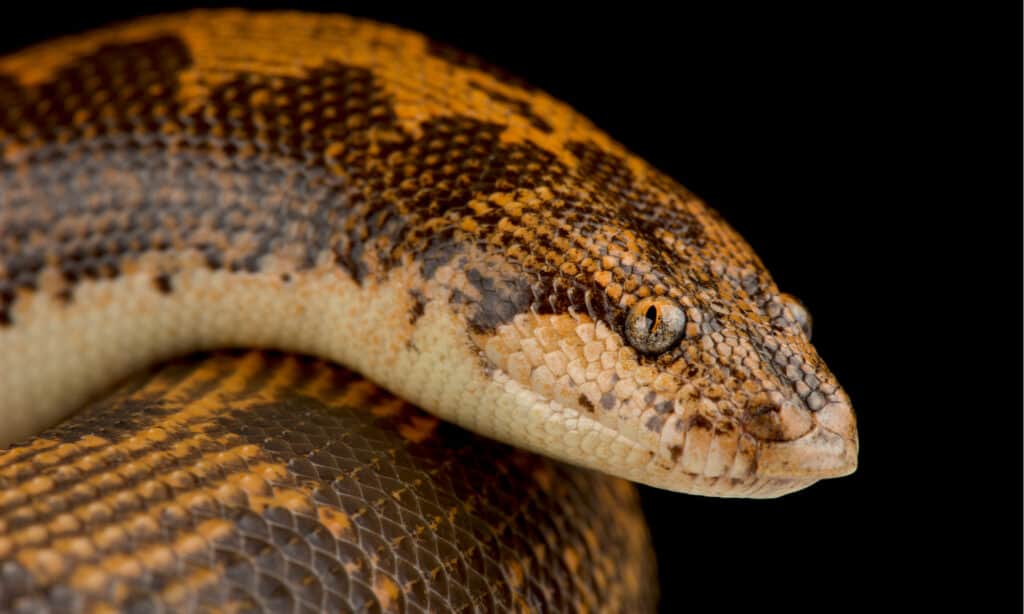
reptiles4all/Shutterstock.com
Native to arid regions in Africa, Kenyan sand boas only grow to a max of about 2 feet long. They’re easy to care for, and they’re known for being docile, so they make great beginner snakes.
While it’s not recommended that sand be used with most other snakes, the Kenyan sand boa needs a sand substrate. Once per day, waste and other litter will need to be scooped out of the sand. The entirety of the sand in the enclosure should be replaced at least once every three months.
4. California Kingsnakes

Creeping Things/Shutterstock.com
While most types of kingsnakes are too large for a 20-gallon enclosure, California kingsnakes are the appropriate size. Because they’re so popular, their personalities have been bred to create a more docile animal, and it’s easy to find a California kingsnake breeder. These snakes are great at escaping. Exceptional care must be taken to ensure that the lid is securely fastened to the enclosure and that any holes or other opportunities to vacate the vivarium have been eliminated.
5. Rosy Boas
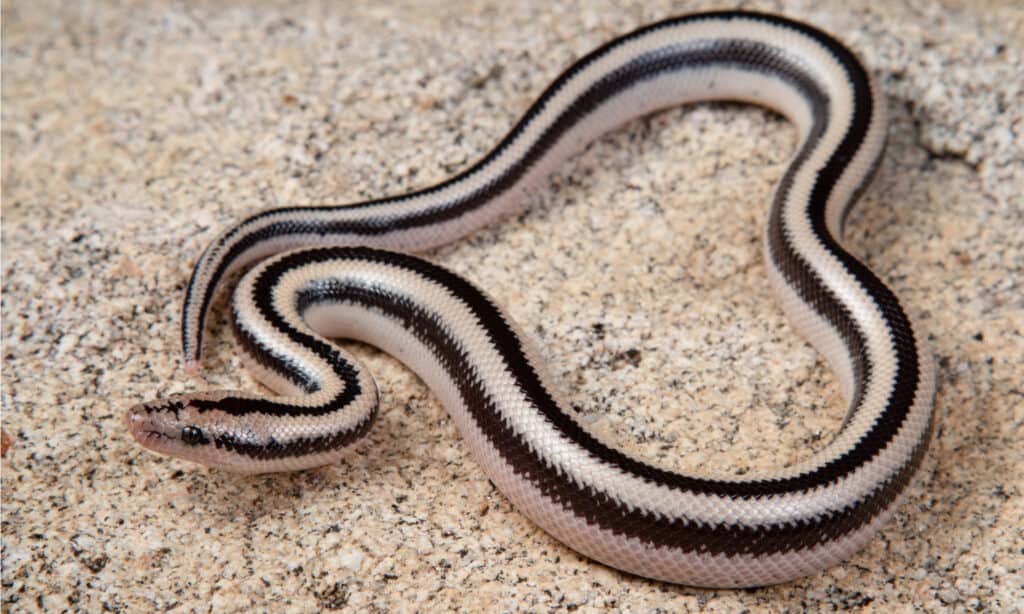
Nathan A Shepard/Shutterstock.com
Rosy boas stay small enough to fit in a 20-gallon tank. They’re unusually slow, and, in the wild, they only reach speeds of up to 1 mph. These snakes are great for beginners because they’re docile and easy to handle. Since they are constrictors, they don’t bite.
Rosy boas are considered one of the safest snakes you can own, as well as one of the cutest because of their pink coloration and stripes. These snakes are long-lived, surviving up to 40 years in captivity. They’re a great choice, but they’re a lifetime commitment.
6. Western Hognose Snakes
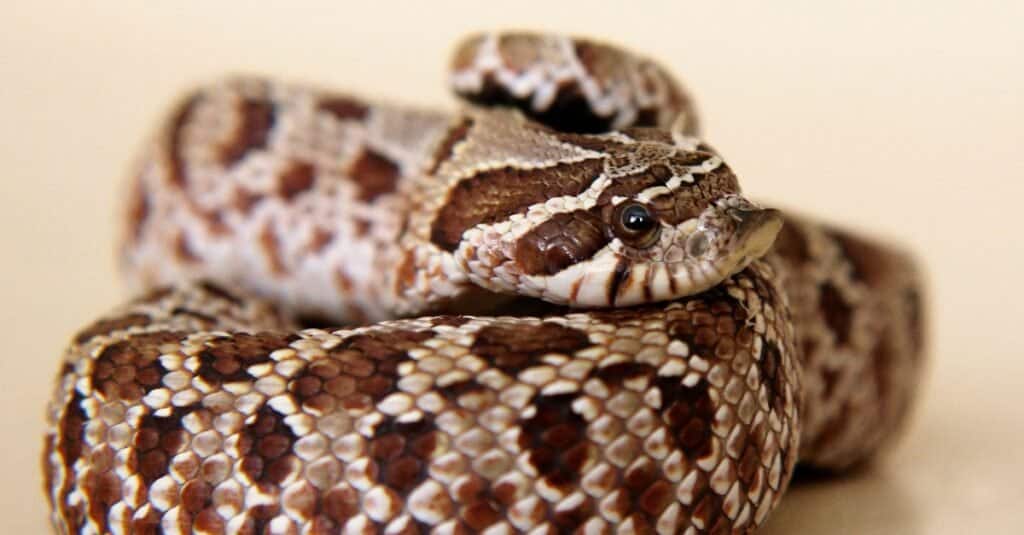
iStock.com/Iuliia Morozova
These snakes have a pig snout caused by a protruding scale which they use to burrow in their substrate. They hardly bite and prefer to play dead instead of attacking, making them easy to handle. They’re appropriate snakes for beginners.
Western hognose snakes like to hang out on the ground, so the bigger the floor space you can give them, the better. Their substrate needs to be deep and appropriate for burrowing, as they spend most of their day rooting around on the bottom of their tanks.
There are a lot of morphs available in an array of colors and patterns.
7. Red Milksnakes
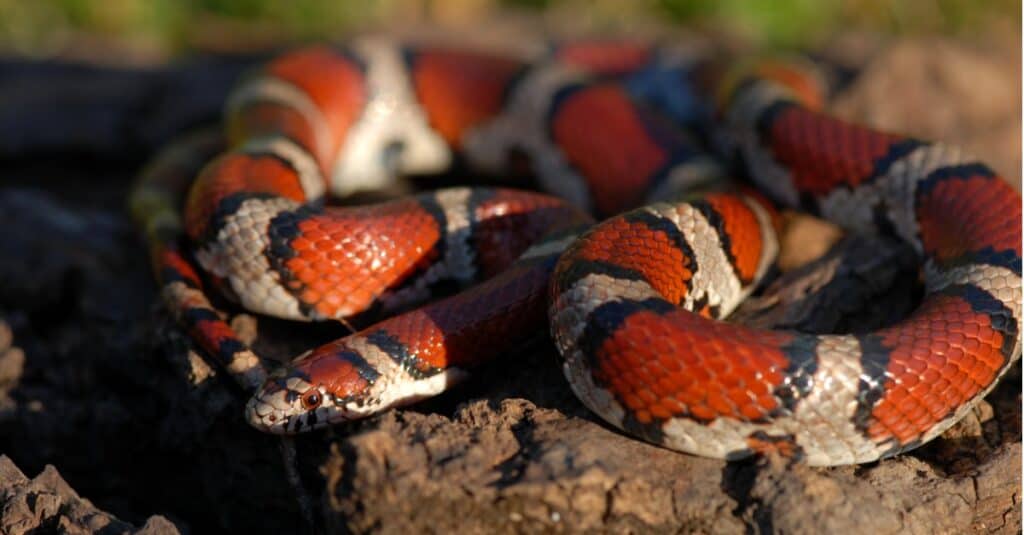
iStock.com/Shoemcfly
Red milksnakes live up to 22 years in captivity and grow up to a length of 2.5 feet. They don’t bite since they are constrictors that squish their prey between their coils to kill them. These snakes are adaptable and can be acclimated to handling even if they’re wild-caught. They make great beginner snakes.
8. Male Corn Snakes
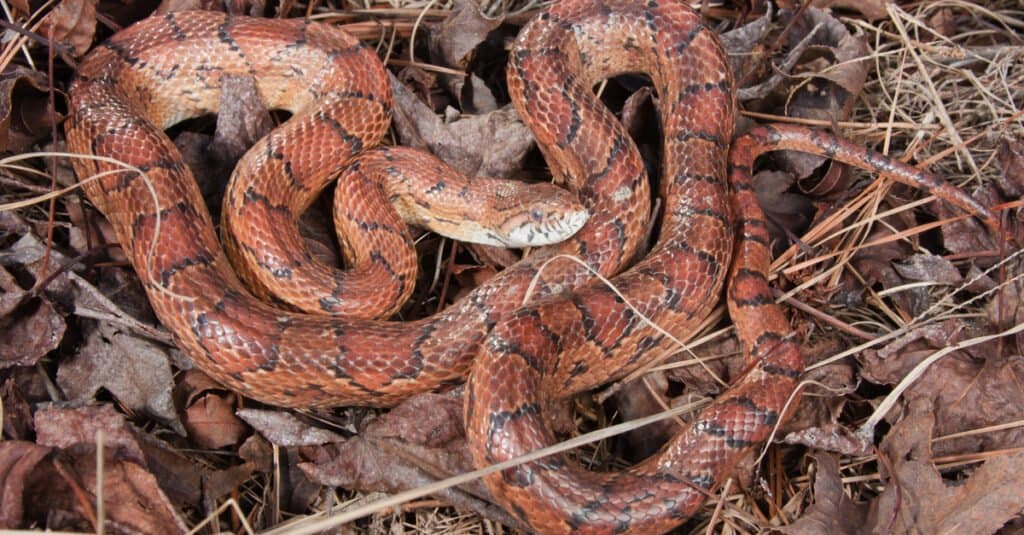
Nathan A Shepard/Shutterstock.com
Male corn snakes are a popular choice among first-time snake owners because they are docile and curious. They like to explore their enclosure, which makes them one of the more entertaining snakes as opposed to a more sedentary choice.
You’ll need to make sure that you’re obtaining a male corn snake for your 20-gallon tank, as females grow to be too large. The smaller males, however, are appropriate for a 20-gallon enclosure.
Too much space may have negative consequences on a corn snake, so while this snake is one of the largest on this list, it’s still appropriate for a smaller enclosure. Females can grow up to 6 feet in length, while males usually average about 4 feet.
Discover the “Monster” Snake 5X Bigger than an Anaconda
Every day A-Z Animals sends out some of the most incredible facts in the world from our free newsletter. Want to discover the 10 most beautiful snakes in the world, a “snake island” where you’re never more than 3 feet from danger, or a “monster” snake 5X larger than an anaconda? Then sign up right now and you’ll start receiving our daily newsletter absolutely free.
More from A-Z Animals
.more-snake-card-image { max-height:140px !important; }
#mobileSnakeQuizControls { overflow: hidden; text-overflow: ellipsis; white-space: nowrap; }
@media (min-width: 481px) {
.mobile-top-content {
display: none;
}
}
#mobileTopContentCTACarouselControls { overflow: hidden; text-overflow: ellipsis; white-space: nowrap; }
.mobile-top-content .more { color: #fff; }
.mobile-top-content a { color: #fff; text-decoration: underline; }
.mobile-top-content a:hover { color: #fff; text-decoration: underline; }
@media (max-width: 480px) {
.mobile-top-content {
background-color: #06a10b;
color: #fff;
text-align: center;
/*height: 60px;
padding-top:5px;*/
font-size:80%;
/* display: block; */
margin: 0px -30px;
}
}
Considering how long snakes can be, finding the appropriate snake for a 20-gallon tank needs to be a calculated decision to ensure you’re able to provide top-notch care to your pet. All 8 snakes on our list are nonvenomous.
A snake is almost always kept in a 20-gallon long tank to accommodate a longer snake. Almost all snakes have a sizeable lifespan, so any snake is a long-term commitment. Only snakes up to four feet long should be kept in a 20-gallon tank.
Most snakes will use a substrate made from shavings, and you must never use aromatic shavings as these will cause respiratory problems. All snakes will also need a hot side and a cool side for their tank, which can vary a few degrees based on species and the individual in question.
button.pulse {
transform: scale(1); animation: pulse 2s infinite;
box-shadow: 0 0 0 0 rgba(11, 247, 25, 1);
}
@keyframes pulse {
0% { transform: scale(0.90); box-shadow: 0 0 0 0 rgba(11, 247, 25, 0.5); }
60% { transform: scale(1); box-shadow: 0 0 0 15px rgba(11, 247, 25, 0); }
100% { transform: scale(0.90); box-shadow: 0 0 0 0 rgba(11, 247, 25, 0); }
}
So what are eight snakes that can comfortably fit into a 20-gallon tank their entire lives? Let’s go over some details of these snakes now.
1. Rough Green Snakes

iStock.com/Shoemcfly
Rough green snakes are their striking green color so that they blend into their natural environment. They prefer forests, wetlands, and uplands. Their diet mostly consists of insects. They’re usually between 1.5 to 2 feet long, but they can grow up to 3 feet in length. Wild-caught specimens can be tamed and made into good pets. A captive rough green snake has a lifespan of about 15 years.
2. Garter Snakes

iStock.com/Shoemcfly
Garter snakes usually are 2-3 feet long, though the longest garter snake ever recorded was 4.4 feet long. Their wild habitats are forests, wetlands, fields, and woodlands. They live up to 5 years in the wild and up to 10 years in captivity.
While garter snakes are common and make great pets, it is not advised to capture a wild snake. It won’t have the same demeanor as a pet snake, and it will do anything it can to protect itself, including biting and releasing an offensive odor.
For an unknown reason, garter snakes in captivity react to their specialized diet by developing a smaller head than their wild counterparts. When reintroduction campaigns are undertaken, the survival rate of captive specimens is lower than desired, presumably because the snakes do not have sufficient access to the prey they need due to their head size.
3. Kenyan Sand Boas

reptiles4all/Shutterstock.com
Native to arid regions in Africa, Kenyan sand boas only grow to a max of about 2 feet long. They’re easy to care for, and they’re known for being docile, so they make great beginner snakes.
While it’s not recommended that sand be used with most other snakes, the Kenyan sand boa needs a sand substrate. Once per day, waste and other litter will need to be scooped out of the sand. The entirety of the sand in the enclosure should be replaced at least once every three months.
4. California Kingsnakes

Creeping Things/Shutterstock.com
While most types of kingsnakes are too large for a 20-gallon enclosure, California kingsnakes are the appropriate size. Because they’re so popular, their personalities have been bred to create a more docile animal, and it’s easy to find a California kingsnake breeder. These snakes are great at escaping. Exceptional care must be taken to ensure that the lid is securely fastened to the enclosure and that any holes or other opportunities to vacate the vivarium have been eliminated.
5. Rosy Boas

Nathan A Shepard/Shutterstock.com
Rosy boas stay small enough to fit in a 20-gallon tank. They’re unusually slow, and, in the wild, they only reach speeds of up to 1 mph. These snakes are great for beginners because they’re docile and easy to handle. Since they are constrictors, they don’t bite.
Rosy boas are considered one of the safest snakes you can own, as well as one of the cutest because of their pink coloration and stripes. These snakes are long-lived, surviving up to 40 years in captivity. They’re a great choice, but they’re a lifetime commitment.
6. Western Hognose Snakes

iStock.com/Iuliia Morozova
These snakes have a pig snout caused by a protruding scale which they use to burrow in their substrate. They hardly bite and prefer to play dead instead of attacking, making them easy to handle. They’re appropriate snakes for beginners.
Western hognose snakes like to hang out on the ground, so the bigger the floor space you can give them, the better. Their substrate needs to be deep and appropriate for burrowing, as they spend most of their day rooting around on the bottom of their tanks.
There are a lot of morphs available in an array of colors and patterns.
7. Red Milksnakes

iStock.com/Shoemcfly
Red milksnakes live up to 22 years in captivity and grow up to a length of 2.5 feet. They don’t bite since they are constrictors that squish their prey between their coils to kill them. These snakes are adaptable and can be acclimated to handling even if they’re wild-caught. They make great beginner snakes.
8. Male Corn Snakes

Nathan A Shepard/Shutterstock.com
Male corn snakes are a popular choice among first-time snake owners because they are docile and curious. They like to explore their enclosure, which makes them one of the more entertaining snakes as opposed to a more sedentary choice.
You’ll need to make sure that you’re obtaining a male corn snake for your 20-gallon tank, as females grow to be too large. The smaller males, however, are appropriate for a 20-gallon enclosure.
Too much space may have negative consequences on a corn snake, so while this snake is one of the largest on this list, it’s still appropriate for a smaller enclosure. Females can grow up to 6 feet in length, while males usually average about 4 feet.
Discover the “Monster” Snake 5X Bigger than an Anaconda
Every day A-Z Animals sends out some of the most incredible facts in the world from our free newsletter. Want to discover the 10 most beautiful snakes in the world, a “snake island” where you’re never more than 3 feet from danger, or a “monster” snake 5X larger than an anaconda? Then sign up right now and you’ll start receiving our daily newsletter absolutely free.







